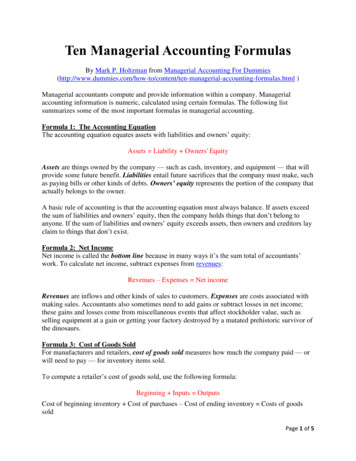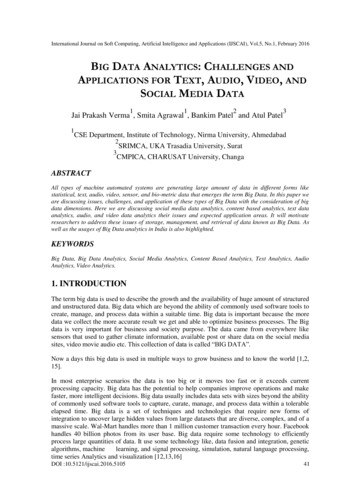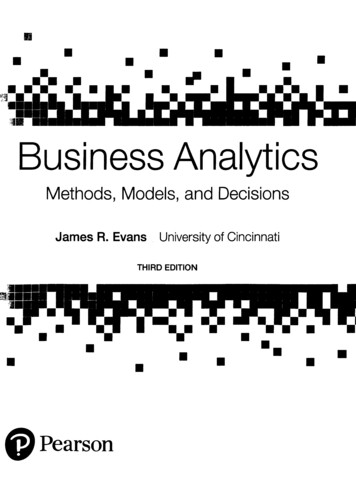
Transcription
ISSN (print):2182-7796, ISSN (online):2182 -7788, ISSN (cd-ro m):2182-780XAvailable online at www.sciencesphere.org/ijispmDeterminants of analytics-based managerial decisionmakingUsarat ThirathonKasetsart UniversityFaculty of Business AdministrationChatuchak, Bangkok nhard WiederUniversity of Technology SydneyUTS Business School,Ultimo NSW 2007, Luise OssimitzUniversity of Technology SydneyUTS Business School,Ultimo NSW 2007, uAbstract:This study investigates how managerial decision-making is influenced by Big Data analytics, analysts’ interaction skillsand quantitative skills of senior and middle managers. The results of a cross-sectional survey of senior IT managersreveal that Big Data analytics (BDA) creates an incentive for managers to base more of their decisions on analyticinsights. However, we also find that interaction skills of analysts and – even more so – managers’ quantitative skills arestronger drivers of analytics-based decision-making. Finally, our analysis reveals that, contrary to mainstreamperceptions, managers in smaller organizations are more capable in terms of quantitative skills, and they aresignificantly more likely to base their decisions on analytics than managers in large organizations. Considering theimportant role of managers’ quantitative skills in leveraging analytic decision support, our findings suggest that smallerfirms may owe some of their analytic advantages to the fact that they have managers who are closer to their analysts –and analytics more generally.Keywords:Big Data analytics; decision-making; quantitative skills; interaction skills; firm size.DOI: 10.12821/ijispm060102Manuscript received: 27 November 2017Manuscript accepted: 20 December 2017Copyr ight 2018, SciKA. General per missio n t o republish in pr int or elect ronic forms, but not for profit , all or part of t his mat er i al is grant ed, provided t hat t heInt ernat ional Jour nal o f I nfor mat io n S yst ems and Pro ject Manage ment copyr ight notice is given and t hat reference made t o t he publicat ion, t o it s dat e of issue, and t ot he fact t hat reprint ing pr ivileges were grant ed by per m iss io n o f SciKA - Associat ion for Pro mot ion and D isseminat io n o f Scient ific Knowledge.International Journal of Information Systems and Project Management, Vol. 6, No. 1, 2018, 27-40 27
Determinants of Analytics-based Managerial Decision-making1. IntroductionDuring the past few years, the terms Big Data (BD) and Big Data Analytics (BDA) have become increasingly importantfor both academics and business professionals in IT-related fields and other disciplines [1]. Furthermore, executivesincreasingly acknowledge the potential benefits associated with BD [2] and global private and public investment in BDhas reached billions of dollars per annum [3],[4]. BD has become a popular term which essentially represents the factthat data generated and available today is big in terms of volume, variety, and velocity [4],[5].But being big does not per se make data useful. It is rather the insights gained from analyzing the data which providebenefits [5], which in turn requires organizations to develop or acquire new quantitative skills [6]. The claimed powerof BDA does not replace the need for human insight [7]. Equipped with BDA experts, who can provide such insightsfrom data, managers are expected to make better (informed) decisions [6],[8],[9] – provided they actually use thoseinsights to guide their decision-making.Some high-performing organizations use BDA as critical differentiator and driver of growth [1],[11],[12], but oftenexecutives still struggle to understand and implement BD strategies effectively [10]. Furthermore, it is unclear to whatextent managers actually use any available BDA output to support their decisions. Some even argue that the biggestchallenge in BDA is that managers do not comprehend how to gain benefits from analytics [11], and even managersthemselves are concerned about their ability to uncover and take advantage of meaningful insights [11]. Accordingly,the first research question in this paper is: Are managers in organizations with sophisticated BDA more likely to basetheir decisions on analytics (facts, evidence) than managers in organizations low on BDA?Being able to provide sophisticated BDA is, however, not the only skill data analysts require. They also have to be ableto effectively relate to, cooperate with and communicate with internal and sometimes external parties. Such professionalinteraction skills are often associated with being able to effectively liaise with stakeholders and sponsors, understand theneeds of internal customers, effectively collaborate and contribute to team results, successfully negotiate and resolveconflicts, and effectively communicate problems and solutions [12]. Accordingly, our second research question inquiresto what extent interaction skill levels of analysts/analytic experts influence the level of reliance on analytics inmanagerial decision-making.Considering that some managers have particular difficulties understanding analytics in the BD era [10], our thirdresearch question addresses the role of managerial capabilities in the context of BDA and decision-making. Managerialquantitative skills (MQS) refer to the collection of experience, skills, and know-how of managers with regards toquantitative methods [13]. But do variations in managers’ quantitative skills actually influence the extent to which theyrely on analytics in their decision-making?To answer these research questions, we collected survey responses from 163 senior finance managers across a broadrange of industries in Australia. The results suggest that managerial quantitative skills are the strongest driver ofanalytics-based decision-making, but both BDA sophistication and interaction skills of analysts also have a significanteffect. Our test results also reveal an unexpected negative effect of the control variable firm size on analytics-baseddecision-making.The remainder of the paper is organized as follows: Section two elaborates on the constructs of interest and makespredictions about their relationships (hypotheses); section three explains the research methods, including constructmeasurement, and section four presents the results. Finally, the implications and the limitations of our research arediscussed in section five.International Journal of Information Systems and Project Management, Vol. 6, No. 1, 2018, 27-40 28
Determinants of Analytics-based Managerial Decision-making2. Theory/Hypotheses developmentBig Data (BD) refers to a set of techniques and technologies that require new forms of integration in order to uncoverhidden value from large datasets that are diverse, complex, and of a very large scale. Today, data are generated,changed and removed more frequently than in the past, and increasingly analogue data are converted into digital form[14]. Consequently organizations need new platforms and tools for analyzing data. “Analytics is the science of analysis”[15, p. 86]. Data analytics uses data for quantitative and/or qualitative analysis to help organizations to betterunderstand their business and markets (knowledge discovery) and to support timely business decisions[5],[20],[24],[16]]. Data analytics in a BD environment is different from conventional data analytics, because many ofthe analytic algorithms used on BD had to be adapted or newly developed in response to the high volume, variety, andvelocity of data [7].Big Data Analytics (BDA) applies scientific methods to solve problems previously thought impossible to solve, becauseeither the data or the analytic tools did not exist [17]. BDA can help organizations to create actionable strategies byproviding constructive, predictive and real-time analytics, and to gain deeper insights in how to address their businessrequirements and formulate their plans [18]. With new technologies and analytic approaches, BDA can providemanagers with information for real-time planning and continuous forecasting [7],[18],[19]. BDA techniques are capableof analyzing larger amounts of increasingly diverse data. With algorithms advancing BDA can help improve decisionefficiency and effectiveness [20]. In summary, BDA can have a significant impact on decision-making processes,provided managers perceive analytic output as useful and use it to support their decisions [28]-[30].Research findings are still inconsistent in terms of what managers base their decisions on. Even when managers claim touse a rational approach in their decision-making process, they still also use soft problem structuring methods [21] andheuristics (including intuition) to cope with bounded rationality at some stages in this process [22]. However, whenanalytic results are insightful and timely, and when they contradict intuition, managers are said to set aside theirintuition and rely on data [7]. We therefore predict as follows:H1: Big Data analytics sophistication leads to more analytics-based decision-making.Sophisticated analytic methods and tools are, however, not always enough to convince managers of the usefulness ofanalytics. Analysts also need to be able to properly communicate solutions or insights to their stakeholders – bothverbally and visually [23]. In addition, they require relationship skills to facilitate an interaction and ongoingcommunication with decision makers [24] and to enable a shift from ad hoc analysis to an ongoing managerialconversation with data. As analysts make discoveries, they have to be able to communicate what they have learnt andsuggest implications for new business directions [23]. In the context of business analytics, such “interaction skills arerepresented by the business analyst's ability to relate, cooperate, and communicate with different kinds of peopleincluding executives, sponsors, colleagues, team members, developers, vendors, learning and developmentprofessionals, end users, customers, and subject matter experts” [12, p. 207]. It is argued that analysts’ interaction skills(AIS) can improve managers’ perceptions of the usefulness of analytic output, and therefore have a significant impacton managerial decision-making processes.H2: Better interaction skills of analysts lead to more analytics-based decision-making.Quantitative skills refer to the ability of generating, transforming and interpreting numerical data by applyingmathematical and/or statistical rules, thinking and reasoning [25]. Quantitative skill requirements vary depending on theroles and responsibilities of individuals, as well as the scope and sophistication of the organizational operations and data[26]. Analytic professionals are expected to have advanced quantitative skills, but whether such capabilities are requiredat the managerial level is questionable – even more so as newer Artificial Intelligence (AI) methods are capable ofmaking decisions without human involvement.On the other hand, research shows that organizations still need managers with sound quantitative skills [27]. Managersare required to identify and define business problems, ideally with having quantitative solution methods in mind.International Journal of Information Systems and Project Management, Vol. 6, No. 1, 2018, 27-40 29
Determinants of Analytics-based Managerial Decision-makingDecision makers are also required to use their judgment and focus on what they perceive to be potentially important soas to enable the selection of the right subsets of the available data [10],[28]. Managers also need quantitative skills inorder to properly evaluate analytic outputs (of new analytical methods) [27] and to correctly deploy resulting actions intheir organizations [27].BDAAISH1H2ABDMH3MQSSIZE (Control)Figure 1: Research ModelWhen competing with analytics, quantitative skills are also required at the strategic decision-making level [29],[30], andprevious studies suggest that there is indeed a positive association between managers’ quantitative skills and the qualityof their decisions [31],[32]. In fact, engineers often become successful CEOs, because they are detail-oriented andpossess strong quantitative and problem-solving skills [33].As far as the use of analytic ‘output’ in managerial decision-making is concerned, we expect that managers withstronger quantitative skills perceive such output as more useful, because they better understand the methods used togenerate it. Accordingly, they will be more likely to base their decisions on analytics.H3: Managers’ quantitative skills have a positive effect on analytics-based decision-making.In our research model (Figure 1), we control for firm size, because larger firms are considered to (a) have morefinancial resources available for investment into BDA (both analytic human capital and analytic tools); (b) be in a bettermarket position for hiring managers with strong quantitative skills (MQS); and (c) have more formalized procedures fordecision-making and therefore rely more extensively on analytical decision support [34]. As such effects may alsointeract with the relationships predicted in H1-H3, we also test for moderation effects of firm size.3. Research methodTo acknowledge the exploratory nature of this research, a cross-sectional survey was considered to be the most suitableresearch method [35]. The survey targeted CIOs and senior IT managers of Australian-based medium to large for-profitorganizations. The survey procedures were guided by Dillman et al. [36]. As each variable in the hypotheses is latent,constructing proper indicators and scales was essential. This process was informed by previous academic studies, butwhere required, practitioner literature was also consulted. During questionnaire design, necessary procedural remedieswere applied to control for and minimize the impact of common method biases [37]. The face and content validity ofInternational Journal of Information Systems and Project Management, Vol. 6, No. 1, 2018, 27-40 30
Determinants of Analytics-based Managerial Decision-makingthe prototype of the questionnaire as well as the appropriateness of Likert scale endpoints were assessed as follows [37]:Five experts in survey research were invited to evaluate the draft questionnaire, and their feedback was used to refinethe design and content of the survey. The revised version of the questionnaire was then delivered to a group of industryexperts and academics for final pilot testing.3.1 Construct MeasurementIn the absence of any (known) measurement scale for analytic sophistication in the context of BD, we had to developour own scales. As a starting point, we operationalized BDA along three dimensions [38]: (a) analytic methods, (b)analytic tools and (c) quantitative skills of analysts. Analytic methods include a vast range of statistical methods,machine learning/data mining/artificial intelligence, operations research techniques (e.g. optimization models), anddecision analysis [39]. Analytic tools refer to software applications that analytic professionals use in data analytics.They range from basic spreadsheet models to business intelligence (BI) tools, large-scale statistical packages, datamining suites, data visualization tools, high performance computing tools and combinations of the former. During pilottesting, respondents were asked to rate their analytics expert or expert team in terms of quantitative skills and in termsof frequency of use of various analytic tools and methods, as derived from industry surveys [40],[41] and professionalguidelines [12] (Table 1). The analysis of the pilot test data revealed that skills and methods cross-loaded on each otherand that the skill-construct did not meet the required measurement quality criteria. The latter was therefore droppedfrom the survey, and only the first order constructs methods and tools were used to generate BDA sophistication as asecond order formative construct BDA (following the recommendations of Wetzels et al. [42]).Table 1 - Descriptive statistics and validity and reliability measures (first order constructs)Analytic ToolsSpreadsheets#BI Planning/Reporting SuitesData ETL/Management SolutionsStatistical Suites – Basic UseStatistical Suites – Advanced UseSpecialized Data Mining SuitesData Visualization ToolsBD/High Performance Computing Tools#Analytic MethodsStatistical MethodsMachine Learning, Data Mining, AIOR, Optimization MethodsPath Modelling#Analytics-based Decision-MakingDecisions about Products/Services/MarketsDecisions about Strategic/Key SuppliersDecisions about Outsourcing/BPMDecisions about Sales and MarketingDecisions about OperationsDecisions about ProcurementOverall, Organization Acts on Insights#Analyst Interaction SkillsUnderstanding the needs of (internal) 05.024.524.781-75.22Std. Dev.Composite 4461.4451.237International Journal of Information Systems and Project Management, Vol. 6, No. 1, 2018, 27-40 31
Determinants of Analytics-based Managerial Decision-makingMeanStd. Dev.(Range)Collaborating & contributing to team results5.201.319Liaising with stakeholders & sponsors5.111.252Effectively communicating problems and solutions4.961.2441-7Managers’ Quantitative SkillsStrong analytical skills (senior managers)4.521.619Strong numerical skills (senior managers)5.471.353Subst. experience with quantitative methods (senior mgr.)3.661.599Competent in statistics (senior managers)3.741.574Strong analytical skills (middle managers)4.421.494Strong numerical skills (middle managers)5.311.420Subst. experience with quantitative methods (middle mgr.)3.501.668Competent in statistics (middle managers)3.661.6081-tailed: p .05*; p .01**; p .001***; # Indicator omitted from final analysisComposite Interaction skills refer to the ability of the analyst to relate, cooperate and communicate with internal and externalparties. Successful interaction requires liaising with stakeholders and sponsors, understanding the needs of internalcustomers, collaborating and contributing to team results, negotiating and conflict resolution1, and effectivelycommunicating problems and solutions [12]. In our study, respondents were asked to rate their analytics expert/team inthose areas on a seven point Likert scale (1 very poor and 7 excellent).Experience and competence in analytic methods are typically associated with the quality of decisions [31]. Quantitativeskills assist managers at all levels with identifying problems, interpret scenarios and solutions and monitor/assess theimpact of decisions. Considering the seniority of the survey respondents, we did however only ask for an assessment ofthe analytic competencies of other (non-IT) senior and middle managers. Quantitative skills encompass generalnumeracy skills (mathematics) and proficiency in statistical concepts and methods and other quantitative methods (suchas Operations Research methods). Respondents were asked to rate the level of quantitative skills of their senior andmiddle managers in those areas on a seven point Likert scale (1 strongly disagree and 7 strongly agree). We alsoincluded two reverse coded questions to assess – and confirm – the quality of the responses.When deciding about the measurement scale for analytics-based decision-making, the following constraints had to beconsidered: (a) the level of seniority of the respondents, and (b) the cross-sectional nature of the survey. Toacknowledge the former, the questions were kept broad, representing the tactical and strategic levels of decision-making[43]. To comply with the latter constraint, the questions had to be applicable to all industries in the target sample.Respondents were asked to rate for each decision area to what extent their organization relies on insights derived fromdata analysis/analytics (Likert scale: 1 strongly disagree and 7 strongly agree) (Table 1).Firm size was measured using a scale based on the number of full-time equivalent (FTE) employees distinguishingsmall (50-100 FTE employees), medium (101-500) and large business units (501 ). Organizations with less than 50FTE employees were excluded, because overall they were not expected to have dedicated BD-Analysts.1‘Negotiating and conflict resolution’ loaded poorly on the analyst interaction skills construct and was therefore eliminated.International Journal of Information Systems and Project Management, Vol. 6, No. 1, 2018, 27-40 32
Determinants of Analytics-based Managerial Decision-making3.2 Survey responseThe initial survey invitation was emailed to 1,595 potential respondents, but 263 invitations did not reach the addressees(bounce-backs). A total of 174 responses were received during the survey period, but 11 had to be excluded, becausethey did not meet the selection criteria (e.g. a minimum tenure of one year in that organization, or a minimum responsetime of five minutes). The final response rate of 12.24% may appear low, but is not unusual in Australian businesssurveys, even more so as BD is still an emerging topic for many. 84% (43%) of the responses came from organizationswith more than 100 (500) FTE employees, and CIOs (52.1%) and other senior IT managers (47.9%) were almostequally represented.3.3 Data characteristics and qualityIn order to determine appropriate analysis and testing techniques (parametric vs. non-parametric) [44], test for normalitywere conducted for both indicator data and latent constructs. Both the Shapiro-Wilk test and the Kolmogorov-Smirnovtest revealed that none of the indicators is normally distributed (p .05). Accordingly, we used non-parametric dataanalysis and testing techniques (PLS-SEM and bootstrapping) [45].In addition to the procedural remedies applied during the development of the questionnaire, post-hoc statisticalremedies were used to test for potential method bias [37]. Harman’s single factor test was run across the set of 31measurement indicators yielding seven factors with Eigenvalues exceeding 1, therefore indicating that common methodbias is not present.Responses were also tested for non-response bias by comparing early and late responses. The results of independentsamples test (Levene’s Test for Equality of Variances and t-Test for Equality of Means) confirm that there are nosignificant differences in the indicator values between the early (n 83) and late (n 80) response group.After the elimination of four low-loading indicators, all remaining items have significance levels of p .001 and loadprimarily on their assigned construct. The measurement model was further assessed for reliability and validity of theconstruct measures. Reflective measurement models are assessed for: (a) internal consistency (composite reliability), (b)indicator reliability (composite reliability), (c) convergent validity (average variance extracted and communality), and(d) discriminant validity [35],[45]-[47]. Table 1 confirms that the first three of those criteria are fully met. The FornellLarcker criterion [48] was applied to assess for discriminant validity of latent constructs, and all of them meet thecriterion (Table 2).Table 2 - Fornell-Larcker criterion for discriminant validityToolsMethodsABDMIA yst Interaction Skills.370.256.445.866.364.484.584Managers’ Quantitative SkillsValues in the diagonal are the square-roots of the AVE of each of the constructs.460MQS.771The heterotrait-monotrait (HTMT) ratio between the average of the heterotrait-heteromethod correlations and theaverage of the monotrait-heteromethod correlations [47] is used to further ensure discriminant validity. A HTMT valueof two latent constructs of less than .85 confirms discriminant validity between the pair. Table 3 reveals that all HTMTscores are clearly below the benchmark confirming discriminant validity of our model.International Journal of Information Systems and Project Management, Vol. 6, No. 1, 2018, 27-40 33
Determinants of Analytics-based Managerial Decision-makingTable 3 - HTMT values for discriminant validity (first order Analyst Interaction Skills.423.280.474Managers’ Quantitative Skills.411.543.630IA Skills.5054. ResultsThe structural model shown in Figure 1 was used to test all hypotheses, while controlling for direct and moderatingSIZE effects. The results of the PLS analysis and bootstrapping are presented in Table 1, both for direct (model 1) andmoderating (model 2) effects. The bootstrapped significance levels were identical for the t-statistic, the confidenceinterval and bias-corrected confidence interval methods [35]. The analysis was performed with SmartPLS Version 3.00M3. To report the measurement quality and structural model results (see Table 4) we use the guidelines provided byChin [49] and Ringle et al. [50]. The significance of each effect was determined using bootstrapping with 2,000samples. For the moderating effects the two-stage procedure with standardized product terms was used [35].Table 4. Structural model resultsModel 1f squareModel 2aModel 2bModel 2cBDA ABDM (H1).158*.03.150*.149*.157*AIS ABDM (H2).202**.05.196**.196**.202**MQS ABDM (H3).404***.19*.403***.395***.405***Controls:SIZE ABDM–.128* #).03SIZE BDA.094.01SIZE MQS–.104.01SIZE * BDA ABDM–.132**–.127*–.048SIZE * AIS ABDM–.078SIZE * MQS ABDMR-square: ailed: p .05*; p .01**; p .001***#)The total effect of SIZE on ABDM is –.155*, but the indirect effects of SIZE on ABDM via BDA and MQS are not significant.As predicted in hypothesis 1, BDA sophistication has a significant positive effect on ABDM (H1: .158, p .05),although the effect size in terms of relative R-square contribution (f square) is rather small (.03). Hypothesis 2, whichpredicted a positive effect of AIS on ABDM, is also confirmed (H2: .202, p .01; f .05), but the dominatingpredictor of ABDM are managers’ quantitative skills (MQS) (H3: .404, p .001; f .19), which account for themajority of the R-square in the model.International Journal of Information Systems and Project Management, Vol. 6, No. 1, 2018, 27-40 34
Determinants of Analytics-based Managerial Decision-makingContrary to the rationale for including firm size as a control, this variable has a significant negative direct ( –.128, p .05, f .03) and total ( –.155, p .01) effect on ABDM. Such negative effect is also evident in the moderationmodels (models 2a – 2c), but the interaction terms with SIZE are not significant. As expected, larger firms are able toprovide slightly more sophisticated BDA ( .094, n.s.), but managers in those firms tend to have less quantitativeskills ( –.104, n.s.) and base their decisions to a significantly lesser extent on analytics than managers of smallerfirms ( –.128, p .05).5. Conclusion, implication, and limitationsThe study presented in this paper attempted to determine the impact of Big Data analytics (BDA) sophistication,analysts’ interaction skills (AIS) and managers’ quantitative skills (MQS) on managers’ decision-making behavior, inparticular the extent to which they base their decisions on analytics (rather than heuristics and intuition). The results ofour analysis suggest that while each of those three factors is positively associated with analytics-based decision-making(ABDM), MQS has by far the strongest impact.These findings have important implications for research and practice: First, the results empirically confirm the oftenunverified claims that BDA has an impact on managerial decision behavior insofar as more advanced analytics createsan incentive for managers to actually base their decisions on the analytic insights. Second, the results also confirm thatparticular soft skills expected from analysts [12] do make a difference, i.e. higher interaction skills presented byanalysts do create an incentive for managers to make analytics-based decisions. Third – and most importantly – ourfindings suggest that quantitative skills of senior and middle managers are the main underlying driver of analytics-baseddecision-making [51]. The practical implications of these findings are as follows: Investing in BDA tools and datascientists/analysts creates an incentive for managers to make more informed decisions, even more so if analysts matchtheir technical skills with interaction skills. But in order to fully leverage such analytic resources, it requires managerswho possess strong quantitative skills.One possible interpretation of these findings is that managers with poor quantitative skill do not appreciate the value ofanalytics as much as managers who have developed such skills. Alternatively – or in addition – quantitatively capablemanagers may find it easier to interpret the analysis provided by data scientists and are therefore more likely to use it.Overall, ‘upskilling’ of managers in terms of quantitative methods or using the latter as job selection criteria formanagerial positions may have a more beneficial effect on decision-making than investing into advanced analytic toolsand broadly skilled data scientists.Our study also yielded some unexpected but interesting side-results: When including firm size as control, our testresults reveal that managers in smaller organizations are significantly more likely to base their decisions on analyticoutcomes than managers in large organizations. This finding contradicts the mainstream view held in academicliterature assuming that larger organizations have
on managerial decision-making processes. H2: Better interaction skills of analysts lead to more analytics-based decision-making. Quantitative skills refer to the ability of generating, transforming and interpreting numerical data by applying mathematical and/or statistical rules, thinking and reasoning [25].










